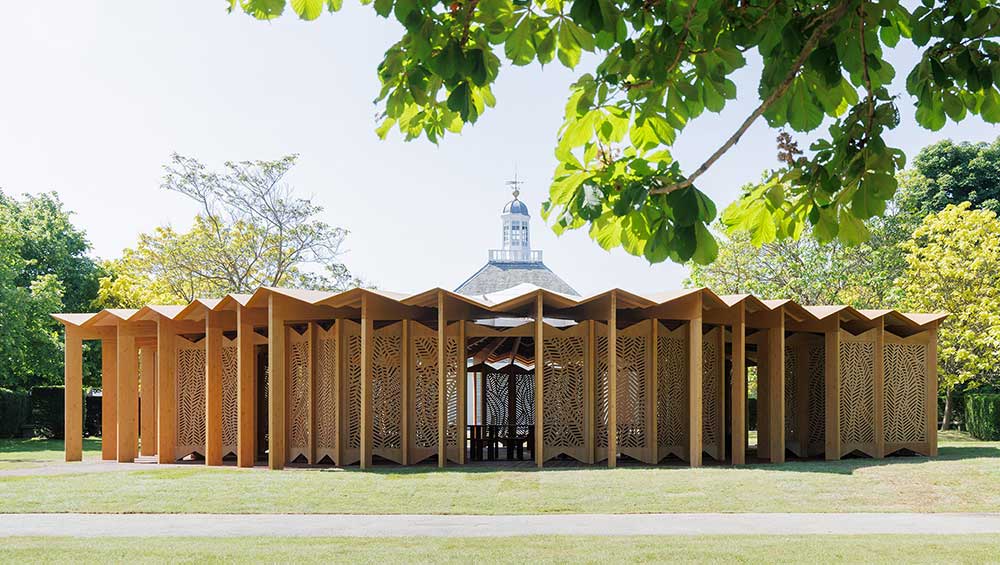
Serpentine Pavilion 2023, designed by Lina Ghotmeh. © Lina Ghotmeh – Architecture. Photo: Iwan Baan. Courtesy: Serpentine.
Kensington Gardens, Hyde Park
9 June – 29 October 2023
by VERONICA SIMPSON
On the first sunny evening in August, after a July that was one of the wettest on record in the UK, I headed out to visit Lina Ghotmeh’s Serpentine Pavilion. I had spoken with Ghotmeh, a Paris-based, French-Lebanese architect (b1980, Beirut), before the unveiling of the finished pavilion, À Table, and was excited about finally experiencing what she had conceived very much as a social space, an invitation for people to sit down and debate and share food and ideas.
I had even brought my own dinner - thinking that others might well have the same idea. However, despite finding my 10-minute walk from South Kensington underground station to Hyde Park unusually busy with lounging workers and relaxing holidaymakers, the Pavilion itself was sparsely occupied, even at 5.45 in the evening. Perhaps it was the inhospitable opening hours that put people off: the space is open between 10am and 6pm. Or maybe it was the presence of three burley, black-clad security people, parading the perimeter (and then looming over us to remind us that the pavilion was closing in a few minutes).
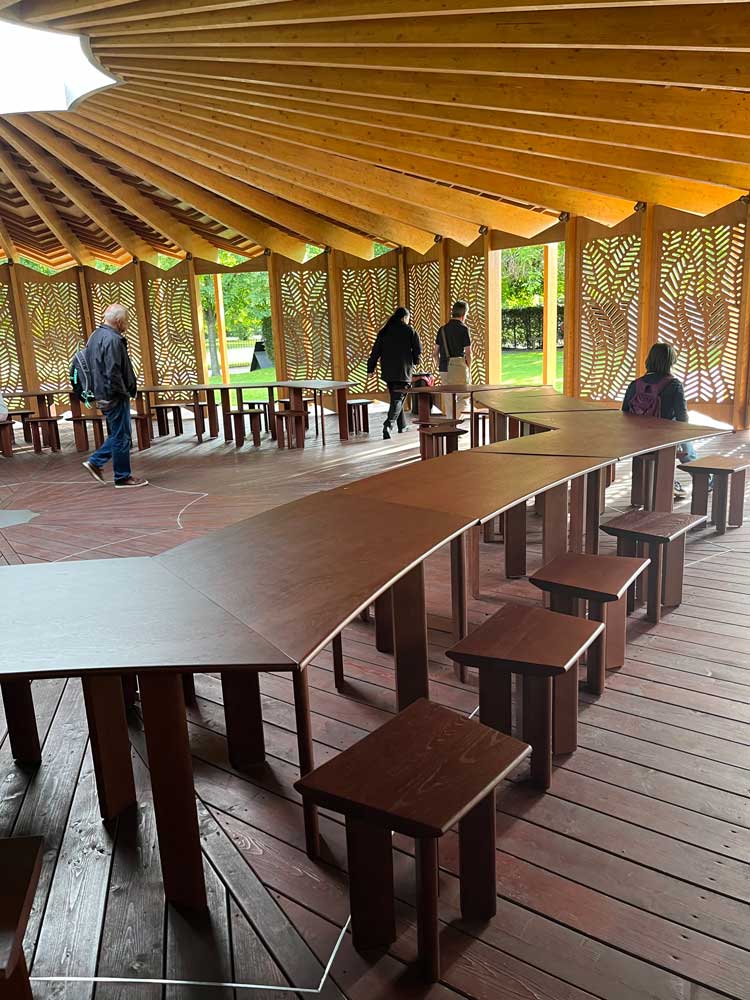
Serpentine Pavilion 2023, London, designed by Lina Ghotmeh. Photo: Veronica Simpson.
You can’t create a space for dining without the provision of a cafe, which is not a given with the Pavilion commission. This one does have a cafe, which is run by Benugo, the chain that operates most of the museum cafes in London, and the press release promised a menu of local and seasonal produce, co-created with Ghotmeh for a Mediterranean influence. But, from its somewhat hidden location at the back, the cafe appeared to have a limited menu of snacks and drinks; there was no kitchen, and therefore no delicious smell of cooking or even coffee to lure hungry visitors. Was Ghotmeh aware that her elegant space for food and gatherings would have such a diminished offer? Or that it would be shut to visitors just when most working Londoners and hungry tourists might be wanting to relax – and well before most people sit down to dinner? That hardly seems in keeping with the “spirit of the Mediterranean” that the press release said Ghotmeh was channelling.
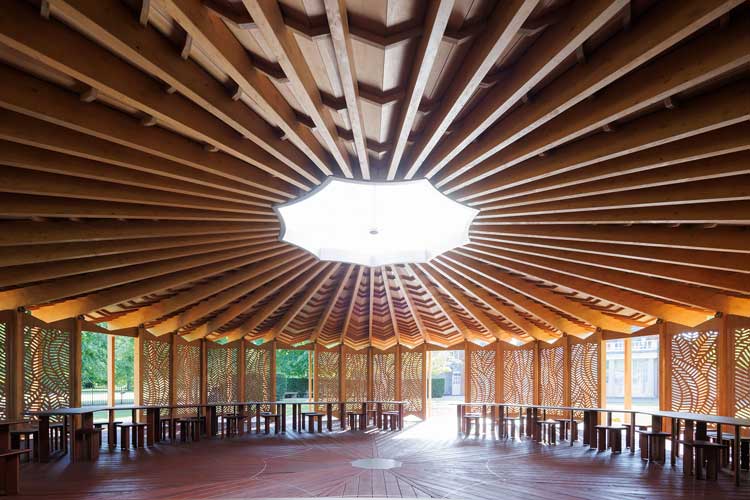
Serpentine Pavilion 2023, designed by Lina Ghotmeh. © Lina Ghotmeh — Architecture. Photo: Iwan Baan. Courtesy: Serpentine.
However, aside from the limited menu and restricted hours, there is plenty to entice folk towards this, the 22nd Serpentine Pavilion commission. A fully permeable timber structure dialogues nicely with the neighbouring trees, with its slim, vertical pillars supporting an overarching, pleated roof said to be inspired by a palm leaf. A nine-sided aperture carved out of its centre allows light to penetrate, though thankfully not rain, thanks to an elegant white parasol covering it. The dialogue with nature continues in the leaf patterns cut into the fretwork panels that sit at angles between the slim timber columns supporting the roof’s scalloped edges. The low roofline was apparently inspired by Malian togunas, gathering places with low ceilings that encourage people to sit down.
This structure also sits lightly in its surroundings – Ghotmeh positioned it so as to avoid any impact on surrounding trees’ root structures - and in its carbon footprint: it uses sustainably sourced timber and can be easily demounted and reassembled elsewhere (as usual, the plan is that it will be sold to a lucky collector after its five-month stay in the park).
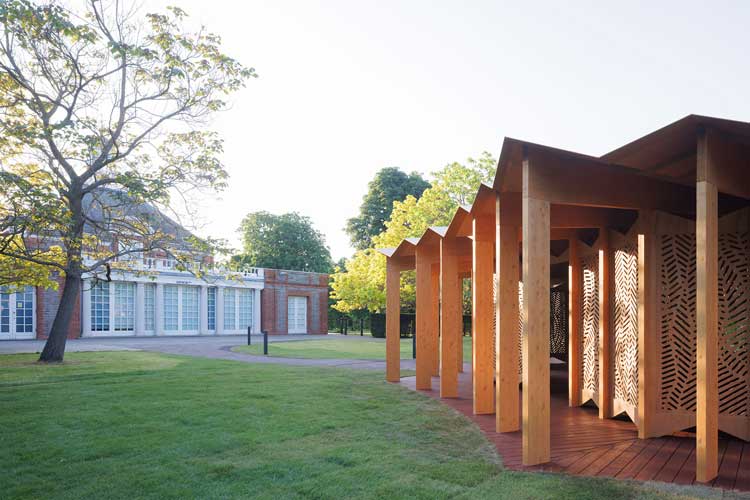
Serpentine Pavilion 2023, designed by Lina Ghotmeh. © Lina Ghotmeh — Architecture. Photo: Iwan Baan. Courtesy: Serpentine.
Some of the details – aside from the truncated hospitality offer - indicate that Ghotmeh’s fine intentions have got lost in translation, or in a spate of value engineering. The glulam (glued laminated timber) spruce pillars around its edges are varnished in a strange, glowing, orangey-yellow that doesn’t tone in with the dark brown and grey bark of the surrounding mature trees. Once inside, there is a marked shift to a palette that is more harmonious with the park beyond: the folded plywood roof and its beams are reddish-brown, in sympathy with the maroon timber floor, and matching bespoke furniture that Ghotmeh designed (and the Conran Shop created) – a nonagonal sequence of connecting but separable tables, with solid-feeling stools whose edges taper, like those of the tables.
There are many nice details: the elegantly thinned edges of the glulam roofbeams, as well as the repetition throughout of the pavilion’s nonagonal geometries; that lightwell outline is replicated below in slim steel rods embedded into the decking, with the same feature recurring further out in the decking along the edges of the table; I also realise the decking itself follows that nonagonal geometry. But other elements disappoint: some critics have taken exception to the decorative screens and their perforations, cut (for reasons of cost) digitally, in a process known as computer numerical-controlled milling. Rowan Moore, in the Observer, called it “a cheap and lifeless technique, the stuff of online garden furniture catalogues”.

Serpentine Pavilion 2023, London, designed by Lina Ghotmeh. Photo: Veronica Simpson.
Ghotmeh told me her inspiration was also about the multiple thresholds one crosses on the approach to the pavilion. How are these thresholds experienced? Perched beside the Serpentine South gallery – a quaint, 1930s building conceived and used as a teahouse – I would say the first threshold you cross towards it is when you leave the buzzy space of Exhibition Road, with all its museum-related pedestrians, then traverse the busy road circling Hyde Park and enter the park itself. There is always a welcome sense of calm as greenery dominates your field of vision. A few strides into the park, I can see the pavilion and the dialogue Ghotmeh referenced, as the vertical pillars echo the horizontals of their neighbouring trees. As you get closer, you notice that the elliptical roof, with its serrated edging, fringes, protects and shades, just as the nearby tree canopies do. But are the perforated screens protecting visitors from sun, or do they read as excluding those who might like to come inside? They could be interpreted either way.
There is no specific doorway through which to enter, but the screens, angled around the structure, part sufficiently at various points to create a few obvious entrances or exits. Just as there is no right way to enter or leave a forest, there is no right way to enter this pavilion.
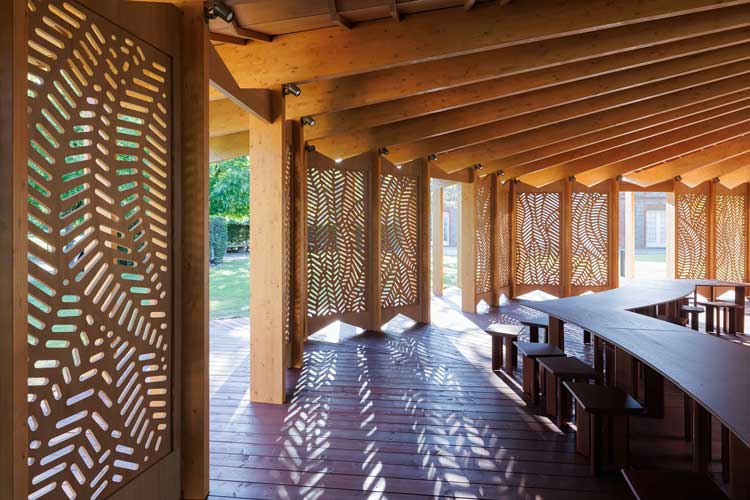
Serpentine Pavilion 2023, designed by Lina Ghotmeh. © Lina Ghotmeh — Architecture. Photo: Iwan Baan. Courtesy: Serpentine.
Once inside, you can enjoy the decorative interplay of sunlight percolating into the pavilion through the screens, as well as through the lightwell in the roof. But the overall atmosphere – without the rich, sensory addition of food and a crowd of people sitting à table, as Ghotmeh intended, is somewhat formal. There is no buzz of excited conversation, just some hushed dialogue between the odd couple, while others stare at their phones or take photos. I also felt that, although the screens are here to provide welcome shade on a hot day, such summers are hardly a given in the UK. And the last thing I wanted, on the first warm evening for ages, was to have that light and warmth blocked out.
Ghotmeh and I discussed the meaning of the annual Serpentine Pavilion commission now, given that its social and cultural context has shifted so radically since its inception: 22 years ago, it was conceived to introduce contemporary architecture to what was then a highly resistant UK public. It gave many international practices that have now gone on to become global stars their first UK commission; but now London is filled with contemporary buildings by international and home-grown architects. So, it needs to speak of other things.
Gotmeh said: “For me, there are multiple questions when you make such a pavilion. Because it’s a bit of a time apart, a commission to think of what can architecture talk about, in a park and in our times? And what kind of message can it bring forward, symbolically and spatially, in the way it’s constructed? I thought it would be nice that the place talks about togetherness, coming together around what most often brings people together, the relationship to the planet and to the Earth. We are at a critical juncture because of climate change, and the responsibilities that we have as humans on this planet.
“I think it’s really not about building icons, or objects that are spectacular and want to become objects of consumption. It’s trying to go beyond architecture, it’s architecture as a meaningful act, and essential to our environment, that brings wellbeing and enhances our relationship to nature and to each other. And, of course, making beauty as accessible as possible.”

Serpentine Pavilion 2023, London, designed by Lina Ghotmeh. Photo: Veronica Simpson.
It does all that – or it would, with a more generous provision of entertainment and food and extended opening hours. I could imagine this pavilion being a wonderful night-time space, were that option made available, and live music and piles of delicious, fragrant food offered – ideally, a feast for 50, who could then crowd around its purpose-built feasting table, filling the pavilion with life. In fact, publicity images of it at night show how beautifully the space responds, lit up like a lantern, golden rays pouring through the screens and the structure’s perforations. There are evening events planned, but only a handful.
I guess what this pavilion really says is that when a building promises hospitality and then the public programme fails to deliver, there is always going to be disappointment.